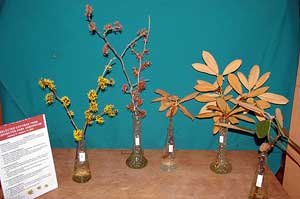January Color Appears at the Washington Park Arboretum
1) Hamamalis mollis (Chinese Witch-hazel)
- Hamamelis mollis is a species of witch-hazel native to central and eastern China.
- It is the most fragrant of all witch-hazels and worth growing for that characteristic alone. It is disease resistant and easy to grow.
- Located in the Witt Winter Garden.
2) Hamamalis x intermedia ‘Hiltingbury’
- Hamamelis x intermedia hybrids are crosses between Japanese witch hazel (H. japonica) and
Chinese witch-hazel (H. mollis). - The brilliant orange, coppery, scarlet and red fall colors of this large spreading shrub are
striking; its early spring flowers are pale copper, suffused with red. - Located in the Witt Winter Garden.
3) Rhododendron bureavii
- R. bureavii occurs in the wild in two fairly limited areas in northern Yunnan,
China, in open pine forest and rhododendron thickets. Discovered by Père Delavay in
1896. - Its handsome glossy dark green leaves are thickly felted with rusty-brown, very noticeable
on the young growth. - Located at the top of Rhododendron Glen, near the hydrangeas.
4) Rhododendron degronianum
- Growth habit is very tight and compact with deep glossy green leaves that are covered on the
undersides with soft, fawn-colored indumentum. - Located by the upper pond in the Rhododendron Glen.
5) Rhododendron galactinum
- Native to Sichuan, China; discovered and introduced by E.H. Wilson in 1908.
- Has large leathery leaves, up to 20 cm. long, with a buff-gray or cinnamon-brown indumentum
underneath. - Located on the upper trail near the top of Loderi Valley.
